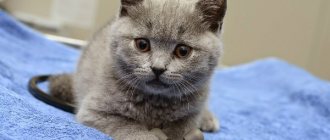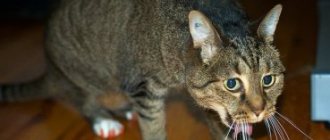DEGREES OF BURN
• 1st degree - redness, tenderness of the skin and slight swelling.
• 2nd degree - in addition to the previously listed signs, blisters appear, which subsequently burst. • 3rd degree - blackening (charring) of tissue and tissue necrosis (death). HOW CAN YOUR CAT BE BURNED
• Boiling water, soup, fire - these are thermal burns.
• Alkali or acid are chemical burns. • Burning in the sun is a radiation burn. THERMAL BURNS
If you were walking into the living room with a cup of hot tea in your hands, and your beloved Murzik threw himself at your feet, and you dropped the cup with curses, partly on him, partly on your bare legs - most likely it will be a 1st degree burn (with Murzinka, of course, you don’t count here at all!).
1st degree burn
The cat's skin is red, swollen and painful. Help
• Cool the burned surface with cold water for 5 minutes. • Treat with a weak solution of potassium permanganate (pink). • Treat with Traumeel-gel or, if there is no gel, drop a Traumeel ampoule onto the burn site. • If there is no Traumeel, you can treat with Panthenol or Alazol aerosol. • Do not cover the burn surface with napkins or bandages. • Treat the wound with Terricin spray, a remedy for the treatment and prevention of infected burns. 1st degree burns can be treated at home and usually resolve within a few days. Treat the burn surface 3-4 times a day. It should crust over and dry out, but if the surface becomes wet and an unpleasant odor appears, it means the burn has become infected. Treatment with Terracin spray gives very good results for infected burns. If you manage to trip over Murzik with a pot of boiling fatty soup in your hands, most likely the poor fellow will receive a 2nd or even 3rd degree burn.
How dangerous are burns?
Healthy skin is a barrier that protects the animal’s body from environmental influences. The burned area loses its protective function - the risk of infection entering through the burn increases. In addition, this:
- pain;
- discomfort;
- disability.
If the burn covers a large area of the body - more than 15%, then there is no good prognosis for recovery; you will have to fight for your pet. If a cat's burn exceeds 50% of the total body area, then the animal will most likely die.
In addition to the skin, the pet can burn the oral cavity (electric shock when biting through wiring) and the upper respiratory tract (inhalation of acid steam, hot smoke). These types of burns not only bring significant discomfort to pets, they are actually life-threatening. For example, an animal may develop swelling of the respiratory tract due to a burn. As a result, the pet will no longer receive enough oxygen and will die as a result.
Healthy skin is a barrier between the body and the environment. It protects against infection and excessive fluid loss. Burnt skin loses its protective properties, so there is a risk of developing severe infectious complications, sepsis. Among other things, burns mean pain, discomfort, and restriction of movement.
If less than 15% of the body surface is damaged, then the prognosis for recovery is good; patients with burns of more than 50% of the body surface have a poor prognosis and high mortality.
In addition to skin burns, animals can have burns to the oral cavity - for example, from chewing electrical wires and electric shock, and burns to the upper respiratory tract (for example, from inhaling smoke from a fire). Burns to the mouth can cause severe discomfort and make eating temporarily impossible. Burns to the respiratory tract can be fatal because they lead to swelling of the respiratory tract, which prevents the animal from taking a full breath.
2nd degree burn
The cat's hair has fallen out or is easily pulled out at the burn site, the skin is brown, and blisters have formed on it. Help
• Immediately wash off whatever you burned your cat with - soup, porridge, etc. • Cool the burnt surface - pour cold water over it, apply an ice pack (just do not apply ice), put it under a tap with cold water and hold it for as long as possible. • When you cool a burn site, all processes in the burned area are suspended, and the surface seems to enter a state of “anabiosis.” • A burned paw can simply be placed in a jar of cold water. • Give an anesthetic injection.
Electrical shock burns
Such burns most often occur when a cat chews an electrical wire while playing. The consequences of electric shock in a cat are severe burns, swelling of the larynx and lungs. When providing first aid, it is necessary to turn off the electricity and remove the cat from the source of electric shock. If you do not know how to turn off the electricity, or do not have the opportunity to do this, then drag the cat away with a wooden stick or a broom (not metal).
If possible, immediately call an emergency veterinarian and follow their recommendations. If this is not possible, then treat the cat’s burns with a weak solution of furatsilin or potassium permanganate. Then, wrap the victim in something warm and immediately take her to the doctor. Only he can prevent or relieve swelling and treat burns in a cat.
Chemical burns in cats
The most unpleasant thing about chemical burns is that the substance continues to affect the skin for a long time, even after you have removed it from the surface, it seems to “permeate” the skin. Therefore, it is necessary to carry out a neutralization reaction. But before doing this, try to wash off all the chemicals from the cat in the most careful way, rinse long and thoroughly! Wear gloves to avoid getting burned yourself. Help • Neutralize the acid with alkali (1 teaspoon of baking soda per 1 glass of water). Wet a sterile cloth generously and place it on the burned area. As the napkin dries, moisten it again (water it) with a soda solution. • The alkali is neutralized with acid, a weak solution of acetic and citric acid. The steps are the same - moisten the cloth and apply it to the affected area. • In case of burns with quicklime, the affected area must be filled with oil (vegetable, sea buckthorn, vaseline).
Thermal injury assessment
- Inability of an animal to move away or escape from a heat source, heat
- Inability of an animal to sense a heat source, such as in neurological deficits
- Dehydration of an animal
- Poor peripheral perfusion
- Poor peripheral perfusion (blood supply) to tissues in the animal
- Less hair than usual
- Concomitant medical conditions, such as Cushing's syndrome
It is not uncommon for veterinarians themselves to inflict thermal burns on their patients; for example, electric heating pads can become very hot: prolonged contact of local areas of the skin with such a heat source can lead to deep and widespread burns. Less commonly seen are contact burns caused by improperly grounded electrocautery plates.
After initial stabilization of the patient, the main goal is to close the resulting defects as quickly as possible. Therefore, assessing the extent of the burn and the area of the damaged surface is important information for drawing up the correct treatment plan.
The poorly developed capillary network of the superficial plexus explains the lack of blistering in patients (dogs and cats) with thermal burns.
Massive burns can also lead to injury to the tissues under the skin (muscles, bones). A thorough examination is required to evaluate other regional structures, including the eyes, ears, mouth, respiratory system, gastrointestinal tract, genitourinary organs, anus, and paw pads. In addition, patients may be exposed to multiple forms of trauma at the same time: nerve damage, fractures, and other internal injuries that should not be overlooked.
Of course, not all of our pets are raised correctly, so unpleasant situations can often arise due to their excessive curiosity. Such burns in a cat occur when exposed to hot steam, boiling water, hot oil or direct open flame. A particularly dangerous place is the kitchen, because this is where cats most often get burned, trying, no matter what, to steal the treat they like.
Sunburn in cats
Hairless cats or cats with short white fur are more likely to be affected by these types of burns. If you see that the skin at the tips of the ears is inflamed, there are bald spots, and small ulcers may have appeared, it means that your cat is sunburned. It is very good to treat the affected areas with Eplan or Saphroderm for several days. As a rule, in such cases you can do without visiting a veterinarian. Protect your hairless cats from sunburn! For them, such injuries can end in big trouble, given their extensive, unprotected, bald surface!
How to recognize a burn?
External damage
If the animal’s condition is caused by sun activity, then a characteristic dermatosis appears on its skin.
When exposed to chemical solutions, the animal feels severe pain, rushes about, screams, and the skin or mucous membranes turn red. Electrical trauma is manifested by swelling of the upper respiratory organs, difficulty breathing, paralysis of the paws, and impaired cardiac and brain activity. When the eyes are burned, there is lacrimation, swelling of the eyelids, and the cat squints unnaturally. With solar dermatosis, peeling and erythema appear. If a cat burns its paw, body, or accidentally gets boiling water on it, veterinarians distinguish 3 degrees of severity of damage, the symptoms of which are shown in the table:
| Degree | Signs |
| Lightweight | Severe pain |
| Redness of the burned area | |
| Swelling | |
| Minor hyperthermia | |
| The dark footpad becomes whitish, pink or white becomes dark pink or red. | |
| Average | Pain, hyperemia, swelling |
| The appearance of bubbles with clear liquid | |
| Formation of crusts after opening of the bubble and leakage of liquid | |
| Hair loss | |
| Fever, refusal to eat | |
| Heavy | The deep layers of the dermis are affected |
| Carbonization and tissue death | |
| Lack of fur, paws peel off and claws fall out | |
| Temperature increase | |
| Lethargy, apathy, lack of appetite | |
| Vomiting as the body's reaction to pain and intoxication | |
| Bacterial infection and death |
Signs of a burn to internal organs
With such an injury, the animal can breathe with its mouth open.
When toxic chemicals or flammable substances are ingested, as well as from electrical burns in animals, the mucous membranes of the mouth, throat, esophagus, stomach, and brain are affected. Therefore, depending on the cause of the damage, the following symptoms are observed:
- difficult and frequent breathing, sometimes with an open mouth;
- coughing or sneezing;
- impaired or absent swallowing function;
- vomiting blood;
- convulsions;
- paw paresis;
- severe pain, but the animal may remain silent due to pain shock;
- disturbance of heart rhythm and coordination of movements;
- fainting.
Eye burns in cats
Eye burns in cats occur when boiling water or hot oil (thermal) gets into the eyes, as well as chemicals - if the owner mixed up the medications and mistakenly dropped something completely inappropriate into the poor cat's eyes. In any case, the eyes should be rinsed generously with cold water. You can directly expose the injured eye to a gentle stream of water. If the cat does not open the eyelids, you need to open them with force (but not excessive!) and, directing a stream of cool water into the eye, try to wash out everything that got there from the hole. No antagonists (acid-alkali, alkali-acid) should be used! Contact your veterinarian immediately! Before leaving the house, you can give your cat 1-2 drops of Iris eye drops and give a pain-relieving injection of Traumeel. What you need to remember when providing first aid for burns • Do not smear the affected areas with butter, kefir, sour cream and other fatty products that you happen to have on hand! Your task is to cool the affected area, and fat does not allow access to oxygen and perfectly retains heat! • Do not apply ice without a bag. • Wash off anything that burned your cat as quickly and thoroughly as possible. • In case of chemical burns, immediately carry out a neutralization reaction. In case of chemical burns to the eyes, this should not be done; rinse only with water! • Do not puncture or cut blisters. • Do not give cats injections of analgin and Dimed Rol - this is dangerous for them, I will explain why later. • Use special veterinary drugs, i.e., developed specifically for animals.
Medical approach to patients with burns.
Pet owners need to know about the most common mistakes in order to avoid them during first aid. It is forbidden:
- lubricate the burned areas with oil, fatty dairy products (such products do not allow air to pass through, the temperature rises at the burn site, and negative processes are accelerated);
- apply ice directly to the skin, without a bag;
- puncture or cut blisters;
- make injections of Diphenhydramine, Analgin.
Cooling and treatment of affected areas must be carried out immediately. In treatment it is necessary to use drugs intended for animals. In case of severe burns, a visit to the veterinary hospital should be made as soon as possible.
Interesting topics
- How to give injections to a cat
- Combing - caring for a cat's fur
- Cat anti-scratch products, their features, rules of use
- Correct hemoglobin in cats and dogs
- Castration of cats and sterilization of cats: all the pros and cons
- What is cat microchipping and why is it needed?
In addition to tragic situations when animals become victims of fires, there are many everyday “ways” to get burned. Animals spill hot water on themselves, burn themselves on heating devices, grills and barbecues, and chew electrical wires. It is important to remember that animals are often very curious, so you should not leave them unattended if there is a possible source of burns in the room. You wouldn’t leave a switched-on iron next to a small child, would you?
If the thermal effect continues (for example, an animal spilled hot oil on itself), you need to expose the damaged areas to cool water.
First degree burns do not require any treatment, including the use of ointments and treatments. If necessary, you need to protect the burn site from licking with bandages, blankets, and special collars.
Second degree burns and above require a visit to the doctor. If the burns are extensive, before visiting a doctor, you can cover them with a damp cloth and prevent the animal from licking them. It is better not to take additional actions on your own, as this can worsen the damage.
The doctor will take measures for the initial treatment of burns (remove hair and dead tissue). Depending on the severity of the animal’s condition, treatment of burns may require only local treatments, but also hospitalization, intensive care, and in some cases, surgical treatment (removal of dead tissue, skin grafting).
Extensive oral burns that result in the animal being unable to eat may require alternative feeding methods. Otherwise, the patient will die of starvation while the burns heal. For example, feeding through a nasogastric tube, esophagostomy tube, or parenteral (intravenous) nutrition.
Burns of the respiratory tract leading to swelling may require emergency surgery - tracheostomy. This is an operation in which a breathing hole is made in the trachea (neck), below the site of swelling, so that the animal can breathe. If the lower respiratory tract is damaged due to burns, respiratory failure may develop, requiring oxygen therapy and, in some cases, mechanical ventilation.
Maltseva Anna Nikolaevna
Domestic cats are very active animals. It is not surprising that sooner or later they get injured. They can be very diverse: from scratches to burns. Unfortunately, many cat owners believe that their pets can cope with their wounds on their own and therefore can do without the help of their owners. This is a very big mistake.
Cats need careful treatment of their wounds just as much as humans. By the way, licking them does one harm to cats, because the cat’s tongue is rough, and the teeth on it cause damage to the skin, and because of this, healing of the wound slows down. Yes, outdoor cats try to deal with their wounds on their own, but they live shorter lives and have a worse quality of life.
First of all, it is worth noting that a lot of envy depends on the type of injury. Cats are usually injured during fights or while climbing nearby trees, basements, attics, etc. Minor wounds and scrapes should be treated as similar wounds sustained by a person are treated.
First, you need to rinse with cool, clean water, and then cauterize the edges of the wound (cut, scratch) with hydrogen peroxide. Important note: treat only the edges of the wound, and not its middle, otherwise the pain will cause the cat to resist. In addition, the cat will most likely begin to lick the area that is bothering her, and this is harmful, as mentioned above.
Unfortunately, the wound may be more serious. In this case, you will still have to send the cat to the veterinarian to have the wound stitched up. However, before this, the wound still needs to be treated and, in addition, bandaged. Even if there are foreign bodies in the wound, you do not need to remove them yourself. Careless movements can only increase the severity of the injury. Leave this task to your veterinarian.
Another common type of injury that cats suffer is burns. Just like in humans, cats have them to varying degrees. The reasons may vary. Basically, they are connected with the fact that they neglect the danger: they can come too close to the fire, and climb onto the stove and try to stick their face or paw into a pot of boiling soup.
Before you do anything, you need to understand how severe the burn is. To do this, you need to inspect the damaged area (note that the cat will certainly lick the burn site, accompanying this activity with heart-rending meows.) Try to carefully move the hair away from the burn site. If it moves away easily, then this, unfortunately, is not a good sign.
This means the burn is severe. In this case, you need to contact a veterinarian. But before that, to soothe the pain, apply ice to the injury site. It must not be dirty. When the acute pain is relieved, the burned area should be smeared with ointment, which will have an analgesic and anti-inflammatory effect. Bepanten ointment is best suited.
The affected area is likely to develop blisters and blisters. Under no circumstances should they be opened: this will only increase the pain experienced by the cat and complicate the wound healing process. While on your way to the vet, be careful not to disturb your cat's injured area, as this will cause her further distress.
If the burn is mild, then you do not need to contact a veterinarian - it is enough to do all the other steps listed above to relieve the pain and prevent the inflammatory process.
Particular attention should be paid to cases when a cat’s wound begins to become inflamed and rot. Often such phenomena are accompanied by purulent discharge, bleeding, and lack of positive dynamics of wound healing. Swelling of the injured area may also occur, the cat may have a high temperature for a long time, and lethargy may be observed in behavior.
In these cases, you should immediately seek help from specialists. They will conduct a serious examination, disinfect the wound and remove pus, give the necessary injections, and prescribe medications that will allow intensive treatment of the disease. Typically, these medications will be antibiotics. Of course, they weaken the cat's immune system, but complications from the disease can cause much more harm.
To summarize, it is worth noting that in the vast majority of cases, cat wounds are not difficult to treat - the main thing is that help is provided on time and that complications caused by injuries do not arise.
If you were walking into the living room with a cup of hot tea in your hands, and your beloved Murzik threw himself at your feet, and you dropped the cup with curses...
1st degree - redness, soreness of the skin and slight swelling. 2nd degree - in addition to the previously listed signs, blisters appear, which subsequently burst. 3rd degree - blackening (charring) of the tissue and tissue necrosis (death). Boiling water, soup , fire - these are thermal burns. Alkali or acid - these are chemical burns. Burning in the sun is a radiation burn. If you were walking into the living room with a cup of hot tea in your hands, and your beloved Murzik threw himself at your feet, and you dropped the cup with curses , partly on him, partly on your bare legs - most likely it will be a 1st degree burn (with Murzinka, of course, you don’t count here at all!).
Treatment of a patient with burns should be primarily aimed at maintaining the vital functions of the body and improving the general condition during the course of therapy. Correct calculation of surface area can serve as a starting point when administering fluid therapy to patients with severe, deep burns involving more than 20% of their body surface.
The veterinarian knows a lot. He knows not only what to apply to a cat’s paw if it’s burned, but also what product is best to use in each specific situation. In general, the scope of its capabilities is much wider. For example, a veterinarian is a first aid professional. He is accustomed to removing fur and dead tissue; few cat lovers are capable of this with such composure, due to skills.
Among other things, the veterinarian can immediately determine the extent of the damage, which makes it possible to immediately begin treatment of the animal.
If a cat has a burn to its mouth, it may lose the ability to feed. In this case, the doctor will feed the animal by injection or through a nasogastric tube.
Even with complex burns of the respiratory tract due to swelling, a tracheostomy may be necessary - an operation in which the doctor will make a hole in the trachea for breathing.
Still have questions? You can ask them to our site's in-house veterinarian in the comment box below, who will respond to them as soon as possible.
There are several degrees of burns depending on the severity of the damage.
Internal burns of mucous membranes
Stitches, wounds, scratches and other injuries in cats are not treated with brilliant green. When licked, brilliant green affects the tongue, esophagus, and stomach - a chemical burn. If a cat has a burn from brilliant green, give the animal Enterosgel or any available absorbent and immediately contact a veterinarian.
Food burns cause a lot of discomfort, but most often, the epithelium is restored within 10–12 hours. The situation is much more serious if the pet died in a fire. In addition to inhalation of carcinogenic gases, burns of the mucous tract are observed.
A burn to the nasal mucosa in a cat is accompanied by sneezing with the release of mucus and soot, coughing, and shortness of breath. To understand how to treat a cat, you need to identify the depth of the lesion; as first aid, the animal is given a subcutaneous injection of an immunostimulant and an anesthetic drug. An old but proven method - intravenous administration of a veterinary aqueous solution of methylene blue with glucose - quickly restores hemoglobin levels, 0.10–0.15 ml per 1 kg of animal weight.
What to do if the cat gets burned?
First aid
If an animal receives a thermal injury, the owner can use Panthenol.
At home, the owner must be able to assist the pet, since the animal’s life depends on it. Depending on the type of burn injury, first aid is provided as follows:
- Thermal:
- Apply Panthenol to the burnt area.
- Apply a cold compress for 15 minutes.
- Apply a sterile bandage.
- Inject the drug "Ketolong".
- Chemical:
- Neutralize the acid with soda solution.
- Prevent the effect of alkali with a weak solution of vinegar.
- Treat the affected area with diluted potassium permanganate, Furacilin.
- Electric:
- Turn off the power supply.
- Pull the pet away with a wooden mop or broom without metal fasteners.
- Take him to the veterinary clinic immediately, as cardiac arrest is possible.
- Eye burn:
- Rinse the organ with cool running water.
- Apply a sterile bandage to the eye.
- Solar:
- Keep your cat away from direct ultraviolet rays.
- Apply sunscreen with titanium dioxide.
Drug treatment
The animal can be given only those drugs that the doctor has selected for it.
All medications are prescribed by a veterinarian; it is prohibited to treat your cat yourself at home. Thermal burns of a cat's paw pads or other parts of the body can be cured with veterinary medications from the following groups:
- antibiotics;
- steroid medications;
- wound healing liniments;
- painkillers;
- anti-inflammatory.
For solar dermatitis, when the ears and natural bald spots near them are burned, retinoids, vitamin A, and P-carotene are used for treatment. For eye burns, bactericidal, decongestant and anti-inflammatory drugs are prescribed to prevent secondary infection. It is recommended to wear a sterile bandage, blanket or protective collar until the injuries heal.
Surgical intervention
If an animal's limbs are severely damaged, they are removed.
The operation must be done if the animal has a terminal stage of thermal burn. Dead tissue is removed; in severe cases, amputation of the damaged limb is performed. If the burn provokes laryngeal stenosis, a tracheostomy is performed, in which a T-shaped tube is installed in the trachea. Sometimes oxygen therapy sessions are required or the animal is connected to a ventilator. If the cat has burned the mucous membranes of the mouth and throat, after intensive therapy the cat should be fed through a tube or intravenously.
Prevention
You should prohibit your pet from walking on a cold stove, otherwise he will think that it is safe and will also jump onto a hot one.
To prevent the cat from getting burned, it is important for the owner to take care of the safety of sockets and wires by checking the insulation and installing plugs. If the owner is preparing hot food, so that he does not spill on the pet, the cat should be locked in the room for a while. During house cleaning, you should remove the cat so that chemicals do not accidentally come into contact with it. It is recommended not to leave the cat in direct sunlight, especially from 12 to 17 hours.
How to help an animal before visiting a doctor?
If the thermal effect continues (for example, an animal spilled hot oil on itself), you need to expose the damaged areas to cool water.
First degree burns do not require any treatment, including the use of ointments and treatments. If necessary, you need to protect the burn site from licking with bandages, blankets, and special collars.
Second degree burns and above require a visit to the doctor. If the burns are extensive, before visiting a doctor, you can cover them with a damp cloth and prevent the animal from licking them. It is better not to take additional actions on your own, as this can worsen the damage.










